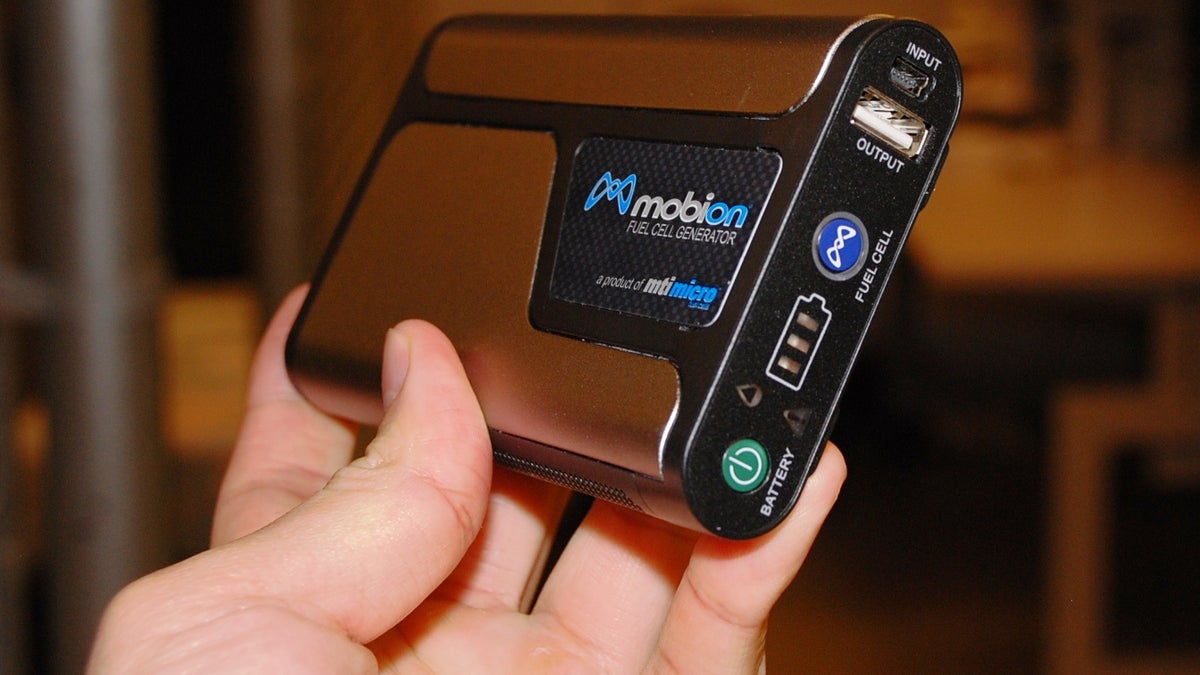Portable fuel cell generator: Green and powerful
CNET's Dong Ngo's take on MTI Micro's Mobion charger, the first portable fuel cell power generator for handheld devices.

I am not a film critic, but I find Tom Cruise and Cameron Diaz's recent action movie "Knight and Day" quite a snooze, for the most part. Spoiler alert: There's one thing I like about the movie, however, and it's the idea of the "Zephyr," a perpetual battery about the size of a regular AA that has enough power to run a small city, forever.
Now powering a small city forever with a tiny battery is quite an ambition and will take at least until 2020 to get (I am an optimist). For now, I'd be happy to have something portable that can power my iPhone for a long time, conveniently and cheaply. And the good news is I have one here, called the Mobion Fuel Cell Generator from MTI Micro. If things go as planned, the rest of you will be able to buy one or something similar by sometime next year.
The Mobion Fuel Cell Generator, which has been in field testing since June, works very similarly to a conventional power generator: you pour gasoline into one end, turn the engine on, and have electricity come out in the other. There are, of course, a few significant differences.
The charger (or the fuel cell engine, in this case) is very small, about the size of a Hershey's chocolate bar and possibly lighter. And it makes no noise; there are no moving parts, hence no emissions, apart from a tiny amount of vapor that's hardly noticeable. The gasoline in this case is a small cartridge full of neat methanol that can be "brewed" from various sources that are environmental friendly.
The charger has a USB port and can charge any device uses this port for charging. With appropriate adapters, it can also used to charge many other electronic devices. When the fuel cell cartridge runs out, you can just replace it with another.
The particular prototype charger also has a built-in rechargeable battery that serves as the "buffer" so that the charging won't be interrupted during the swapping of the cartridges. You can also recharge this "buffer" battery using a regular power source, in case you don't have any new cartridges ready.
Though this works somewhat like using conventional batteries, according to Peng Lim, CEO and chairman of MTI, the fuel cell cartridge is much more efficient. For example, a tiny amount of fuel cell, about 1 ounce, has enough power to provide five or six full charges for the iPhone (equivalently to 25 watt-hours of power).
In fact, in my trials, after one full charge of my iPhone 4, I didn't notice the changes in the level of methanol inside the tiny container. Lim also says fuel cells are much cheaper than regular batteries. The amount of fuel contained in one cartridge costs just a few cents. And most importantly, unlike batteries, the fuel cell cartridges can be completely recycled; the making and use of methanol itself is safe for the environment.
Apart from the charger, MTI Micro's fuel cell engine can be used in many different applications, such as embedded into the devices themselves. According to Lim, the company's engine is small and flexible enough to be used in handheld devices without significantly increasing the device's physical size.
The engine meets the environment specs required for all electriconics. It can work in temperatures ranging from 32 degrees to 104 degrees and in 100 percent humidity levels. It, and the fuel cartridge, are also safe to use on an airplane, Lim says, these are the major differences between MTI's fuel-engine compared with that of other companies.
The use of fuel cells as power sources for portable devices does have some minor shortcomings, however. For example, the engine emits vapor, which will create moisture and may be not suitable for certain types of devices. This also means you'll need to use the device in an open area. The fuel cell engine also requires oxygen to work, which means it can't completely replace regular batteries.
These shortcomings, though, are not serious or applicable to most electronics. They can also be overcome by changing the device's design. Fuel cell generators are also better than solar power in the sense that users can be in control of the power source and hence can use them anytime, anywhere.
According to Lim, the field testing will be completed sometime early next year. The company has been working with OEM vendors and power accessory companies on a variety of applications for the engine.
Who knows, if this idea catches on and the fuel cell engines, as well as their cartridges, become popular and accessible, this might change the way we power portable devices forever; the technology will help make portable devices be completely wireless.

